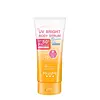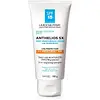MizuMi UV Bright Body Serum SPF 50+ Versus La Roche-Posay Anthelios SX Daily Moisturizing Cream Sunscreen SPF 15
What's inside
What's inside
 Key Ingredients
Key Ingredients

 Benefits
Benefits

 Concerns
Concerns

 Ingredients Side-by-side
Ingredients Side-by-side

Water
Skin ConditioningOctocrylene
UV AbsorberPropylene Glycol
HumectantEthylhexyl Salicylate
UV AbsorberButyl Methoxydibenzoylmethane
UV AbsorberIsohexadecane
EmollientC12-15 Alkyl Benzoate
AntimicrobialDipropylene Glycol
HumectantDicaprylyl Carbonate
EmollientNiacinamide
SmoothingPhenoxyethanol
PreservativeCetearyl Alcohol
EmollientGlyceryl Stearate
EmollientMethyl Methacrylate Crosspolymer
PEG-100 Stearate
Titanium Dioxide
Cosmetic ColorantPotassium Cetyl Phosphate
EmulsifyingPolyacrylamide
C13-14 Isoparaffin
EmollientChlorphenesin
AntimicrobialDisodium EDTA
Acrylates/C10-30 Alkyl Acrylate Crosspolymer
Emulsion StabilisingSodium Hydroxide
BufferingCarbomer
Emulsion StabilisingLaureth-7
Emulsifying1,2-Hexanediol
Skin ConditioningTocopheryl Acetate
AntioxidantGlycerin
HumectantBiosaccharide Gum-5
Skin ConditioningButylene Glycol
HumectantTocopherol
AntioxidantTerminalia Ferdinandiana Fruit Extract
AntioxidantOryza Sativa Lees Extract
Skin ConditioningPrunus Lannesiana Flower Extract
Skin ConditioningWater, Octocrylene, Propylene Glycol, Ethylhexyl Salicylate, Butyl Methoxydibenzoylmethane, Isohexadecane, C12-15 Alkyl Benzoate, Dipropylene Glycol, Dicaprylyl Carbonate, Niacinamide, Phenoxyethanol, Cetearyl Alcohol, Glyceryl Stearate, Methyl Methacrylate Crosspolymer, PEG-100 Stearate, Titanium Dioxide, Potassium Cetyl Phosphate, Polyacrylamide, C13-14 Isoparaffin, Chlorphenesin, Disodium EDTA, Acrylates/C10-30 Alkyl Acrylate Crosspolymer, Sodium Hydroxide, Carbomer, Laureth-7, 1,2-Hexanediol, Tocopheryl Acetate, Glycerin, Biosaccharide Gum-5, Butylene Glycol, Tocopherol, Terminalia Ferdinandiana Fruit Extract, Oryza Sativa Lees Extract, Prunus Lannesiana Flower Extract
Butyl Methoxydibenzoylmethane 2%
UV AbsorberTerephthalylidene Dicamphor Sulfonic Acid 2%
UV AbsorberOctocrylene 10%
UV AbsorberCarbomer
Emulsion StabilisingCyclomethicone
EmollientSimethicone
EmollientDisodium EDTA
Glycerin
HumectantHydroxypropyl Methylcellulose
Emulsion StabilisingIsopropyl Palmitate
EmollientMethylparaben
PreservativePhenoxyethanol
PreservativePropylene Glycol
HumectantPropylparaben
PreservativeWater
Skin ConditioningStearic Acid
CleansingStearoyl Macrogolglycerides
Stearyl Alcohol
EmollientButyl Methoxydibenzoylmethane 2%, Terephthalylidene Dicamphor Sulfonic Acid 2%, Octocrylene 10%, Carbomer, Cyclomethicone, Simethicone, Disodium EDTA, Glycerin, Hydroxypropyl Methylcellulose, Isopropyl Palmitate, Methylparaben, Phenoxyethanol, Propylene Glycol, Propylparaben, Water, Stearic Acid, Stearoyl Macrogolglycerides, Stearyl Alcohol
Ingredients Explained
These ingredients are found in both products.
Ingredients higher up in an ingredient list are typically present in a larger amount.
Also known as Avobenzone, this ingredient is a chemical sunscreen filter that provides protection in the UV-A range.
Avobenzone is globally approved and is the most commonly used UV-A filter in the world.
Studies have found that avobenzone becomes ineffective when exposed to UV light (it is not photostable; meaning that it breaks down in sunlight). Because of this, formulations that include avobenzone will usually contain stabilizers such as octocrylene.
However, some modern formulations (looking at you, EU!) are able to stabilize avobenzone by coating the molecules.
Avobenzone does not protect against the UV-B range, so it's important to check that the sunscreen you're using contains other UV filters that do!
The highest concentration of avobenzone permitted is 3% in the US, and 5% in the EU.
Learn more about Butyl MethoxydibenzoylmethaneCarbomer is a polymer of acrylic acid. Its main role is to create a gel consistency.
A high amount of carbomer can cause pilling or balling up of products. Don't worry, most products contain 1% or less of carbomer.
Disodium EDTA plays a role in making products more stable by aiding other preservatives.
It is a chelating agent, meaning it neutralizes metal ions that may be found in a product.
Disodium EDTA is a salt of edetic acid and is found to be safe in cosmetic ingredients.
Learn more about Disodium EDTAGlycerin is already naturally found in your skin. It helps moisturize and protect your skin.
A study from 2016 found glycerin to be more effective as a humectant than AHAs and hyaluronic acid.
As a humectant, it helps the skin stay hydrated by pulling moisture to your skin. The low molecular weight of glycerin allows it to pull moisture into the deeper layers of your skin.
Hydrated skin improves your skin barrier; Your skin barrier helps protect against irritants and bacteria.
Glycerin has also been found to have antimicrobial and antiviral properties. Due to these properties, glycerin is often used in wound and burn treatments.
In cosmetics, glycerin is usually derived from plants such as soybean or palm. However, it can also be sourced from animals, such as tallow or animal fat.
This ingredient is organic, colorless, odorless, and non-toxic.
Glycerin is the name for this ingredient in American English. British English uses Glycerol/Glycerine.
Learn more about GlycerinOctocrylene protects skin from sun damage. It absorbs UV-B with peak absorption of 304 nm. It is a common sunscreen ingredient and often paired with avobenzone, a UVA filter. This is because octocrylene stabilizes other sunscreen ingredients by protecting them from degradation when exposed to sunlight. Octocrylene is a photostable ingredient and loses about 10% of SPF in 95 minutes.
Octocrylene also acts as an emollient, meaning it helps skin retain moisture and softens skin. It is oil-soluble and hydrophobic, enhancing water-resistant properties in a product.
Those who are using ketoprofen, a topical anti-inflammatory drug, may experience an allergic reaction when using octocrylene. It is best to speak with a healthcare professional about using sunscreens with octocrylene.
The EU allows a maximum of these concentrations:
Learn more about OctocrylenePhenoxyethanol is a preservative that has germicide, antimicrobial, and aromatic properties. Studies show that phenoxyethanol can prevent microbial growth. By itself, it has a scent that is similar to that of a rose.
It's often used in formulations along with Caprylyl Glycol to preserve the shelf life of products.
Propylene Glycol is an odorless, colorless liquid. As a humectant, it helps skin retain moisture. It also aids in delivering active ingredients.
Another role of this ingredient is preventing a product from melting or freezing. Propylene glycol also adds antimicrobrial properties to a product, elongating product lifespan.
This ingredient is considered an organic alcohol and commonly added into both cosmetics and foods.
Those with sensitive skin or conditions may develop a rash when using this ingredient.
Learn more about Propylene GlycolWater. It's the most common cosmetic ingredient of all. You'll usually see it at the top of ingredient lists, meaning that it makes up the largest part of the product.
So why is it so popular? Water most often acts as a solvent - this means that it helps dissolve other ingredients into the formulation.
You'll also recognize water as that liquid we all need to stay alive. If you see this, drink a glass of water. Stay hydrated!
Learn more about Water